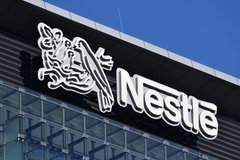
- Industry news
Industry news
- Category news
Category news
- Reports
- Key trends
- Multimedia
- Journal
- Events
- Suppliers
- Home
- Industry news
Industry news
- Category news
Category news
- Reports
- Key trends
- Multimedia
- Events
- Suppliers
Vegan cheese advances: Armored Fresh sharpens fermentation focus to “surpass traditional dairy in taste”
29 Aug 2024 --- Food tech company Armored Fresh is culturing plant-based lactic acid bacteria to mimic the fermentation process used in dairy cheese production. The technology formulates plant-based cheese that “not only tastes similar but also feels like a dairy-based product,” says Rudy Yoo, the company’s founder and CEO.
The company uses a proprietary key-mix — a blend of carefully selected lactic acid bacteria — to simulate a fermentation medium similar to dairy cheese.
“Traditional dairy cheese gets its distinct flavor and texture from a complex fermentation process involving dairy proteins and fats. Replicating these characteristics with plant-based ingredients is particularly challenging due to the differences in protein structure and fat content,” he tells Food Ingredients First.

“By culturing plant-based lactic acid bacteria, Armored Fresh can replicate the fermentation process used in dairy cheese production, which is crucial for the development of complex flavors and textures characteristic of cheese.”
The process has wide implications for the vegan cheese industry, which often grapples with the technical challenges of achieving the melt and stretch properties of conventional cheese. Formulators are focused on tackling this concern, owing to the burgeoning consumption of alt-dairy products worldwide.
In Spain, 38% of consumers are increasing consumption of non-dairy cheese but only 15% are inclined toward dairy cheese consumption, indicates Innova Market Insights’ data. Moreover, in the alt-dairy category, non-dairy cheese product launches rose from 11% in 2019 to 16% in 2023.
 The lack of naturally occurring casein protein that contributes to the melt and stretch properties in dairy cheese complicates plant-based cheese formulation.Additionally, consumers’ acceptance of plant-based cheese is improving. Experts attribute this to various macroeconomics factors, such as vegan lifestyle trends and allergies and intolerances to dairy products.
The lack of naturally occurring casein protein that contributes to the melt and stretch properties in dairy cheese complicates plant-based cheese formulation.Additionally, consumers’ acceptance of plant-based cheese is improving. Experts attribute this to various macroeconomics factors, such as vegan lifestyle trends and allergies and intolerances to dairy products.
Formulation complexities and off-flavors
The characteristic “melt and stretch” of conventional cheese continues to drive innovation in animal-free cheese alternatives as manufacturers aim to meet consumer demands.
“Plant-based cheeses often struggle with achieving the rich, creamy mouthfeel and complex flavors that result from the fermentation and aging of dairy cheeses. The lack of naturally occurring casein — a protein in dairy that contributes to the melt and stretch properties — further complicates the formulation process,” Yoo explains.
Another formulation hurdle is the introduction of off-flavors made with plant-based ingredients, which formulators must mask or eliminate.
“As a result, many plant-based cheeses fall short of consumer expectations, appearing artificial or lacking the depth of flavor found in traditional dairy-based cheeses.”
The company’s plant-based casein “fully replicates” traditional protein’s taste, texture and function. The non-GMO protein can be used in alternative dairy products such as cheese, milk and yogurt and has no taste, color or smell.
Yoo further highlights the need for competitive pricing to make plant-based cheese accessible to a broader audience.
“This approach not only appeals to consumers looking for dairy alternatives, but also positions the brand as a viable option for those who simply enjoy cheese and are curious about plant-based options.”
Environmentally conscious technology
According to the FAO, dairy cheese emanates waste from producing whey, wash water and curd particles, while greenhouse gas (GHG) emissions occur in the form of methane production from ruminant livestock emissions.
Moreover, for every liter of milk produced, the process generates about 2.5 liters of wastewater, further exacerbating the sector’s environmental impact.
The F&B industry’s ongoing mitigation steps include farmer incentives and feed additives to reduce methane emissions and encourage sustainable farming practices. An example is dsm-firmenich’s methane-reducing feed additive Bovaer, which reduces methane emissions from cattle (30% in dairy cows).
Armored Fresh's plant-based cheese taps into the rising consumer acceptance for non-dairy cheese (Image credit: Armored Fresh).Armored Fresh is also working to produce plant-based dairy products with a significantly lower environmental impact compared to traditional dairy products.
“Plant-based dairy production requires fewer resources, such as land and energy and produces fewer greenhouse gasses,” Yoo underscores. “By choosing plant-based ingredients, Armored Fresh reduces the carbon footprint associated with dairy farming, as the dairy farming process is one of the leading causes of global GHG emissions.”
A recent study of 82 pasture-based dairy farms in South Africa from 2012-2022, found that the average carbon footprint across all dairy farming systems was 1.36 ± 0.21 kg CO2eq kg−1 fat- and protein-corrected milk produced. Meanwhile, in Karnataka, India, researchers found methane from enteric fermentation (66.8%) and GHG emission from feed production (23.0%) as “major emission hotspots.”
Yoo maintains that Armored Fresh’s focus on sustainability extends “beyond product development,” with the sourcing of sustainable ingredients from innovative food strains and technologies.
“Going forward, this commitment will work to make the company’s products as environmentally friendly as possible, including its packaging and supply chain practices.”
Exploring new avenues
As the adoption of fully or partially plant-based diets gains ground, Yoo expects the demand for high-quality plant-based products to rise in the future.
“This growth will likely lead to more innovation and variety, with improvements in taste, texture and nutritional profiles.”
Armored Fresh plans to work on continuous innovation in alternative dairy products and expand its diverse product line, enhance existing products and explore new markets.
“Our ongoing R&D efforts focus on developing clean label products that surpass traditional dairy in taste, price competitiveness and nutritional value,” he concludes.
By Insha Naureen










